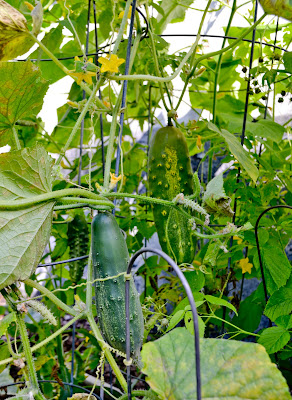Zucchini and lettuce doing nicely...
Cucumber's too...
New to the garden this year were new potato's. I had so much fun digging these up this afternoon...
Grabbed some Rosemary on the way out...
And I'm off to make dinner...
Long Island figures prominently in the history of potato farming and I thought this was an interesting article...
Potato Barns
Potatoes became a staple in North American farming in the early 18th century, but it was not until the early 20th century that American farmers began to cultivate them on a large scale. In the northeast, potato farming in the early 20th century occurred on a large scale in northern Maine, Connecticut, Rhode Island, and New Jersey, as well as New York. By mid-century, potatoes were Long Island’s most important crop (Chamberlain 2006). As potato production became increasingly significant both to the region’s and the nation’s food supply, potato barns were constructed on farms specifically for the purpose of storing large quantities of potatoes. Where farmers had formerly stored small potato harvests in root cellars and other small underground structures, the modern potato barn came to the fore at the turn of the century (Visser 1997).
American potato barns constructed from ca. 1900-1950 are typically banked structures, built into a berm or hillside. The lower portions of most potato barns are usually built of concrete, while the upper portions are of wood-frame construction, clad in wood shingles or clapboard. In order to regulate heat and moisture, potato barns are built with few windows (one or two windows with shutters or shields are often placed at the gable end) and the barns have vents along the roof or at the gable end. The side walls of the barns, where exposed, are commonly reinforced by buttresses, and the barns often have a small brick side
While often located on the same parcel as a farmhouse, potato barns were sometimes constructed on separate parcels a short distance away. Because large-scale potato farming was generally a 20th century phenomenon, advances in vehicular transport enabled the farmer to engage in agricultural activities slightly further from home. While large-scale potato farming in Eastern Long Island persists today, there has been a dramatic shift in recent decades away from an agricultural economy, and towards a service economy.
Potato barns are an iconic building type in Long Island and other parts of New York State where potato cultivation has figured prominently. While many of these structures date to the 20th century and are constructed of materials such as concrete block or poured concrete, potato barns are an aesthetically distinct and historically important part of New York State’s built heritage and agricultural history.







No comments:
Post a Comment